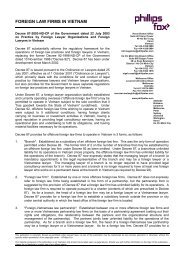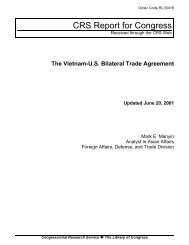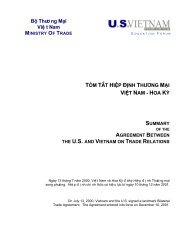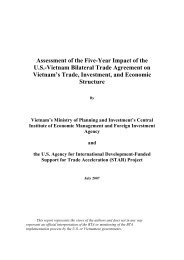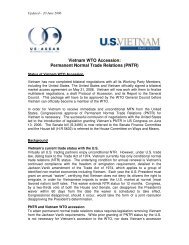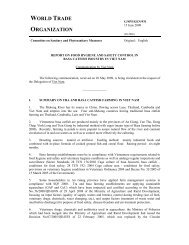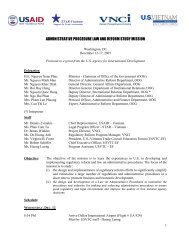Climate risks and adaptation in Asian coastal megacities: A synthesis
Climate risks and adaptation in Asian coastal megacities: A synthesis
Climate risks and adaptation in Asian coastal megacities: A synthesis
- No tags were found...
Create successful ePaper yourself
Turn your PDF publications into a flip-book with our unique Google optimized e-Paper software.
AnnexCAdaptation to IncreasedFlood<strong>in</strong>g: Brief OverviewIn response to the hazard of floods <strong>in</strong>creas<strong>in</strong>gfrom climate change, the <strong>Asian</strong> <strong>coastal</strong> cities <strong>in</strong>the study have a range of possible <strong>adaptation</strong>approaches drawn from exist<strong>in</strong>g flood managementtechniques. Each <strong>adaptation</strong> approach attempts toreduce risk by either reduc<strong>in</strong>g exposure or vulnerability,or by <strong>in</strong>creas<strong>in</strong>g capacity. The <strong>adaptation</strong>measures can be broadly grouped as: 59■■■■■■■■ProtectAccommodateRetreatImproved managementProtection—reduc<strong>in</strong>g exposure withstructural <strong>in</strong>terventionsFlood protection measures seek to m<strong>in</strong>imize theexposure of urban areas to <strong>in</strong>undation from floods.Common eng<strong>in</strong>eer<strong>in</strong>g <strong>in</strong>terventions <strong>in</strong>clude floodembankments, polders, <strong>and</strong> sea walls, frequentlycomb<strong>in</strong>ed with pumped dra<strong>in</strong>age. To allow thetransfer of a flood wave past a city without damage,other protection techniques <strong>in</strong>clude (a) <strong>in</strong>creas<strong>in</strong>gthe hydraulic efficiency 60 of the flood channel withdredg<strong>in</strong>g, widen<strong>in</strong>g, <strong>and</strong> removal of obstructions;(b) divert<strong>in</strong>g the flood flows around the city throughdiversion channels; <strong>and</strong> (c) attenuat<strong>in</strong>g 61 the floodflows upstream with reservoirs or through themanaged flood<strong>in</strong>g of the agricultural <strong>and</strong> wetl<strong>and</strong>areas. With the exception of planned flood<strong>in</strong>g ofagricultural <strong>and</strong> wetl<strong>and</strong>s to attenuate flood peaks,the measures outl<strong>in</strong>ed above would be classifiedprimarily as structural <strong>adaptation</strong> measures.With<strong>in</strong> a city, storm dra<strong>in</strong>age systems are designedto remove storm runoff without flood<strong>in</strong>g.The design discharge for the conveyance systemsare normally based on storms with a return periodbetween 1-<strong>in</strong>-5-years to 1-<strong>in</strong>-10-years, as comparedto design st<strong>and</strong>ards of 1-<strong>in</strong>-30 to 1-<strong>in</strong>-100-year returnperiods commonly used for flood protectionembankments. In an urban sett<strong>in</strong>g, roads, build<strong>in</strong>gs,<strong>and</strong> paved surfaces offer little opportunity for<strong>in</strong>filtration of storm ra<strong>in</strong>fall, which means that mostof the precipitation appears as storm runoff. In thisregard, the predicted <strong>in</strong>crease <strong>in</strong> storm precipitation(rang<strong>in</strong>g from 9 to 15 percent depend<strong>in</strong>g on the city<strong>and</strong> the scenario) will generate a similar <strong>in</strong>crease <strong>in</strong>the design discharge for the storm dra<strong>in</strong>age systems.To provide the same level of protection aga<strong>in</strong>ststorm-<strong>in</strong>duced urban flood<strong>in</strong>g, the cities will needto adapt by either <strong>in</strong>creas<strong>in</strong>g the discharge capacityof their storm dra<strong>in</strong>age systems or identify<strong>in</strong>gways to delay or reduce precipitation runoff. Forexample, <strong>adaptation</strong> measures might <strong>in</strong>clude stormattenuate ponds (us<strong>in</strong>g <strong>in</strong>ner city parks) or mak<strong>in</strong>gstreets, alleys, <strong>and</strong> other paved areas more porousto ra<strong>in</strong>fall to facilitate <strong>in</strong>filtration.Flood protection measures always carry a residualrisk of failure, which can be catastrophic as <strong>in</strong>the case of New Orleans. An important outcome ofthe study is that even for cities with well-designedflood protection plans (e.g., Bangkok <strong>and</strong> Manila),the flood protection measures as currently plannedwill not offer the expected level of protection.59Drawn from IPCC, AR4, Chapter 6, Coastal systems <strong>and</strong>low-ly<strong>in</strong>g areas, Figure 6.11 Evolution of planned <strong>coastal</strong><strong>adaptation</strong> measures, pg. 342, 2007.60Improv<strong>in</strong>g the hydraulic efficiency lowers the flood profile.61Attenuation upstream lowers the flood profile downstream.93



